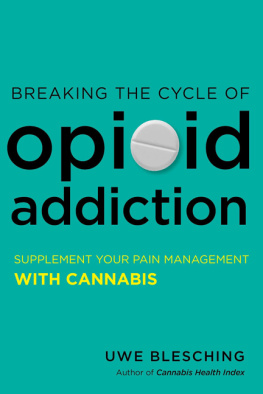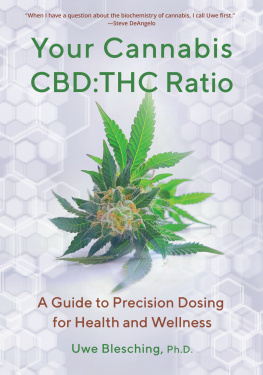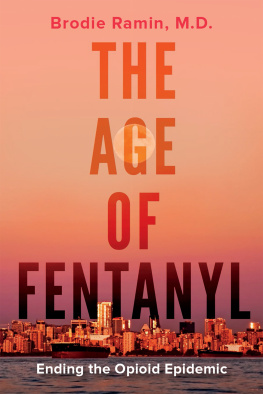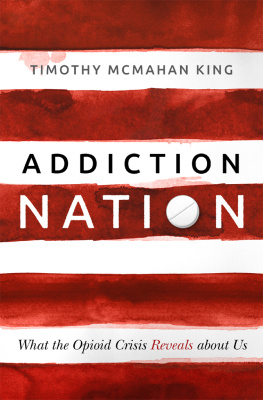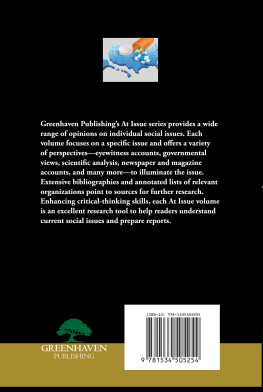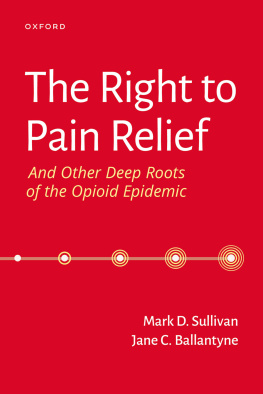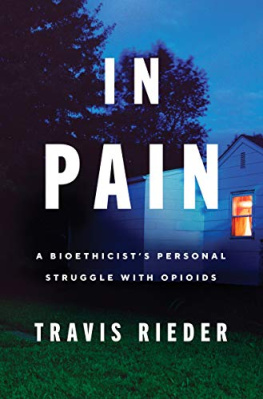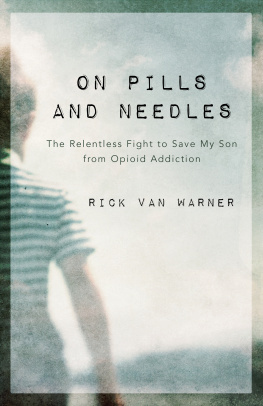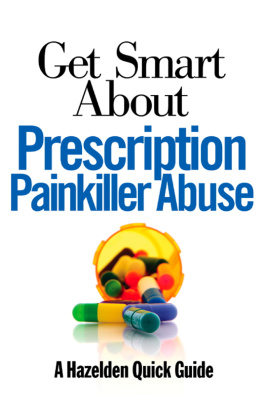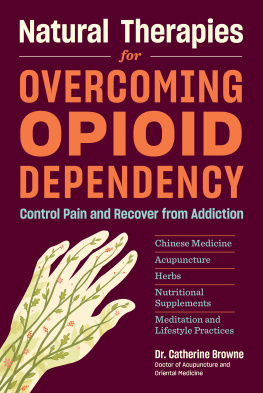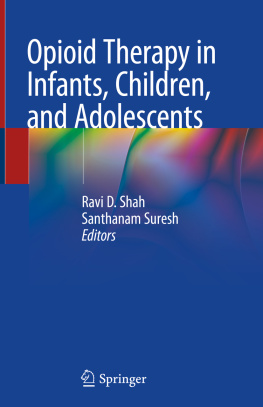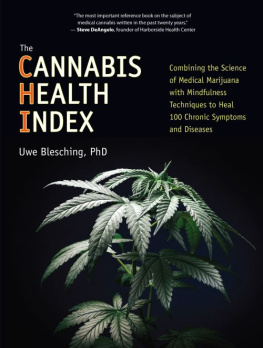
Copyright 2018 by Uwe Blesching. All rights reserved. No portion of this book, except for brief review, may be reproduced, stored in a retrieval system, or transmitted in any form or by any meanselectronic, mechanical, photocopying, recording, or otherwisewithout the written permission of the publisher. For information contact North Atlantic Books.
Published by
North Atlantic Books
Berkeley, California
Cover design by Howie Severson
Interior design by Happenstance Type-O-Rama
Printed in the United States of America
MEDICAL DISCLAIMER: The following information is intended for general information purposes only. Individuals should always see their health care provider before administering any suggestions made in this book. Any application of the material set forth in the following pages is at the readers discretion and is his or her sole responsibility.
Breaking the Cycle of Opioid Addiction: Supplement Your Pain Management with Cannabis is sponsored and published by the Society for the Study of Native Arts and Sciences (dba North Atlantic Books), an educational nonprofit based in Berkeley, California, that collaborates with partners to develop cross-cultural perspectives, nurture holistic views of art, science, the humanities, and healing, and seed personal and global transformation by publishing work on the relationship of body, spirit, and nature.
North Atlantic Books publications are available through most bookstores. For further information, visit our website at www.northatlanticbooks.com or call 800-733-3000.
Library of Congress Cataloging-in-Publication Data
Names: Blesching, Uwe, 1958- author.
Title: Breaking the cycle of opioid addiction : supplement your pain
management with cannabis / Uwe Blesching ; foreword by Stephen Goldner.
Description: Berkeley, CA : North Atlantic Books, 2018. | Includes index.
Identifiers: LCCN 2017058976 (print) | LCCN 2018002770 (ebook) | ISBN
9781623171872 (e-book) | ISBN 9781623171865 (paperback)
Subjects: LCSH: Opioid abuseTreatment. | CannabisTherapeutic use. |
PainAlternative treatment. | BISAC: SELF-HELP / Substance Abuse &
Addictions / Drug Dependence. | MEDICAL / Alternative Medicine. | SOCIAL
SCIENCE / Disease & Health Issues.
Classification: LCC RC568.O45 (ebook) | LCC RC568.O45 B54 2018 (print) | DDC
362.29/3dc23
LC record available at https://lccn.loc.gov/2017058976
North Atlantic Books is committed to the protection of our environment. We partner with FSC-certified printers using soy-based inks and print on recycled paper whenever possible.
Introduction
The fabled city of San Francisco gently spreads over forty-nine rolling hills, covering seven by seven lush square miles of an exotic peninsula in Northern California. Conceived and born in the fever of the gold rush, she quickly became the prime jewel of the Pacific Coast. Her magnificent cauldron of cultures has always been a place of high adventure, from the whiskey saloons and opium dens of the wilder west to the cannabis-smoking Beatniks, the LSD-fueled consciousness-expanding Summer of Love, and the speedy high-tech birth of the dot-com era.
Not surprisingly, attending to an occasional drugged patient was part and parcel of my work as a paramedic for the San Francisco Department of Public Health. However, from the early 1990s on, I began to notice a not-so-subtle change among patients needing emergency assistance.
It became increasingly rare for a shift to pass without getting a dispatch about someone unconscious and not breathing. One patient prone on the sidewalk in the Tenderloin, another crouched over in a public restroom on Mission Street, or yet another falling off a bench in Golden Gate Park. However, there were peak times when a new batch of drugs had entered the streets of San Francisco. No one knew the exact composition, concentration, or quantity to take to get the desired effects. It was in those days that overdoses (ODs) were really common.
There were the usual telltale signs. Pinpoint pupils, pale skin, bluish lips or nail beds, a shallow but rapid pulse. An absent or agonizing respiratory effort on the part of the patient. Needle paraphernalia. Fresh or old needle marks. A wet crotch from melting ice cubes placed there by a concerned friend. I always wondered if that ever worked, or was it just an urban myth? And while I never discovered the truth about ice cubes in the pants, I did learn a lot about opioidsthe good, the bad, and the ugly. I learned a lot about what addiction looks like. I learned a lot about pain. I learned what worked and what didnt on the job. One of the early lessons was patience and attention to details.
The problem, from a paramedics perspective, is that opioids (o-pee-oyds) such as morphine, oxycodone, and heroin bind to opioid receptors in the brain and, depending on the dose or concentration, can cause sedation so intense that the body simply stops any effort to breathe. The opioid antidote is called Narcan, a brand name for naloxone. When it is injected and enters the bloodstream, it quickly reaches the opioid receptors, knocks the heroin or other opioid loose, and immediately takes its place, thus reversing all physical ill effects.
This remarkable transformation occurred very quickly if I was lucky enough to find a workable vein, a bit slower if I had to inject into a muscle. Eventually, either within seconds or within minutes, the patient gasped for air, opened his eyes, and returned from his near-death experience. However, if I was impatient and not attuned to the slow and subtle responses and injected more Narcan to force a more rapid therapeutic result, I ended up injecting enough of the antidote to induce instant withdrawal symptoms in the patient. With the patient now suddenly awake, I was faced with an angry, irritable, aching person who usually and somewhat correctly held me responsible for his ill-fated misfortunes. Inevitably, the fact did not register that mere seconds earlier he was unconscious and in respiratory arrest, minutes or seconds away from death or brain death. Thus I learned the hard way not to be too hasty or too generous with Narcan. I also learned that when the temporary curtain of opioid-based pain relief is pulled back quickly and completely, a raw, tangled web of pain takes its place front and center stage.
It turned out that being slow and deliberate made me keenly aware of my patients individual circumstances. On the surface was the struggle, the compulsion, the lack of control, the aggression, the lawlessness, and irritability. Yet just beneath the surface was a thinly concealed deeper reality of omnipresent pain (physical, mental, and emotional) expressed in loss of meaningful connection and resulting loneliness, in shame and feelings of worthlessness, or in the shadow of utter despair or hopelessness.
One day a young lawyer whom we will call Gene had overdosed at home, and when he awoke after the Narcan ritual he was miserable and in pain. He wanted to use the bathroom to relieve himself before we left for the ER. When he opened the door and came back out I smelled the unmistakable scent of freshly burned cannabis. Gene suggested that he was fine and didnt need to go to the hospital. I checked him out, and indeed, he looked fine. His vital signs were stable, he was lucid, and his physical pain and irritability had diminished. He articulated (and I am paraphrasing) that he was just doing heroin to feel OK enough to function, that he had been doing it for seven years to keep the mostly mental and emotional pain at bay, and that he wasnt addicted.
At first I didnt think too much about it. After all, when you work in the emergency medical services (EMS), pain is all around you. For twenty-four hours straight, seven days a week, with no breaks on holidays, pain is everywhere. From one call to the next, you are thrust into another persons worst time of their life. Sadly, even outside the extremes of EMS, too often pain is omnipresent in some way. And it seems to be getting worse today.
Next page
